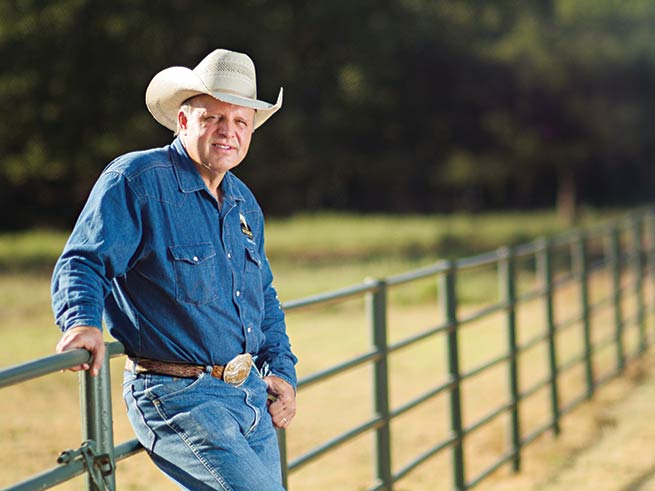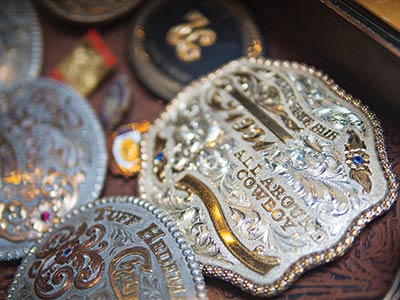
Cody Lambert
Photo by John Stankewitz
Amidst bright lights, blaring rock music and the roar of a rowdy crowd, the cowboy climbs on and grips the braided rope.
The chute opens and the bull goes into his signature routine of bucks, spins, kicks and twists, as the rider's fate slowly becomes apparent. No matter if he gets bucked off, stays on for eight seconds, or has the kind of ride that will earn him a place among bull-riding legends, the rider will walk away knowing that he had one of the best bucking bulls possible — because the man who got the bull there, Cody Lambert, has been in his boots before.
As livestock director for the Professional Bull Riders (PBR), the organization behind one of the world's fastest growing sports, Lambert relies heavily on his storied rodeo career to benefit the riders of today. He qualified for the National Finals Rodeo nine times between 1981 and 1993, consisting of seven trips in bull riding and three trips in saddle bronc riding. In 1992, he was one of 20 bull riders who helped establish the PBR. And he's been selecting bulls for the organization's events ever since.
“It's not any kind of rocket science,” Lambert says of his job. “I'm looking for the toughest bull — the one that if they ride him, they'll get the highest score.”
PICKING THE PERFECT BULL
Lambert began picking bulls for the PBR while he was still riding. In the infancy of the organization, he says that the co-founders would do whatever was needed to produce the event, and his maturity and experience in dealing with stock contractors led him to have a strong say in which bulls would be used.
After reconstructive knee surgery, which led to his retirement in 1996, Lambert knew it was time to look for something else. The PBR Board of Directors wanted him to continue selecting bulls for the events, and he agreed to a full-time position in 1997.
Each week, Lambert spends time reviewing records and watching videos from his home office in Bowie, Texas, to help him determine which bulls will be invited back to PBR competitions. There are more bulls available than ever before, and a bevy of records are available at the click of a mouse, but Lambert keeps his selection criteria simple.
“I only try to look at how hard they buck,” he states. “I don't look at their reputation. I don't want to know what they did last year; I want to know what they did last week. What they're doing right now is important; what they've done in the past doesn't mean they are capable.”
The overwhelming increase in producers raising rodeo stock and the number of quality bulls available has turned Lambert's job around in a way he finds humorous, as his biggest challenge used to be finding enough good bulls to use.
“It was hard to find enough good bulls for the PBR finals,” Lambert recalls. “Now every week is like the finals, and in the last five to 10, I've had to decide which ones don't get to go.”
His job requires a high level of objectivity, and Lambert says he refuses to get attached to any of the bulls. Despite that, he has nothing but respect for the bulls as athletes, often speaking in awe of their athleticism and competitiveness.
“It's the same for humans, horses and bulls — there are lots and lots and lots of good ones. The great ones are few and far between and have the same physical skills as the not-so-good ones, but they apply them in a much better manner. And the great ones are there every time you call their name,” he says.

Photo by John Stankewitz
LIFE OUTSIDE THE ARENA
When not at an event, Lambert spends time with his family on his ranch in Bowie, Texas. He and his wife, Leanne, say they have always considered themselves “country people.” Even during the rodeo years, they thought about how they could afford to buy a place in the country.
The couple purchased their first tract in 1985, and bought their current property in late 2010 with financing from Capital Farm Credit. Stocked with cattle, horses and more than a few dogs, the Lamberts enjoy their ranch with their son, Riley, and his wife and infant.
“I am proud to have Cody and Leanne as customers of Capital Farm Credit because they share in our values and effort to preserve rural America and the Western lifestyle,” says Capital Farm Credit Vice President Travis Thorne, the Lamberts' loan officer.
Lambert actually fell in love with the ranch more than 20 years ago before he realized they would eventually own it. At the time, he was running cattle on some adjacent property owned by his in-laws. When a cow got out one day, he had to track it through a neighbor's property. He told Leanne how pretty the land was, but didn't give it much more thought until her late brother purchased the property less than 10 years later and built a house on it. When he wanted to sell the acreage, the Lamberts jumped at the chance to purchase it. Since then, they have customized the house and added an arena.
“I never thought I'd be able to buy a place like this, and the PBR is the only reason I ever could,” he says.
In the PBR founders' quest to create a sport in which every rider has a chance to earn money, the organization has also created new opportunities for the next generation of riders, thanks to endorsement deals and television exposure. In a highly physical sport where retirement comes with more than just a few bumps and bruises, Lambert says that these opportunities allow the really great riders to enjoy their retirement.
He sits on the board of the Rider Relief Fund, which helps injured riders of all levels through times of rehabilitation from what are sometimes career-ending injuries. Again relying on his years of riding, Lambert's role is to provide insight into the extent of the injuries to help determine how to grant funds.
“Our sport is as hard as any other job, and you have to dedicate yourself to it when you're young and you don't learn how to do a lot of other things,” he says. “I was lucky I didn't have to leave.”
— Staff